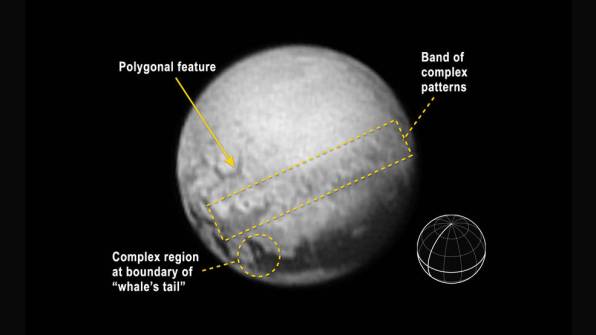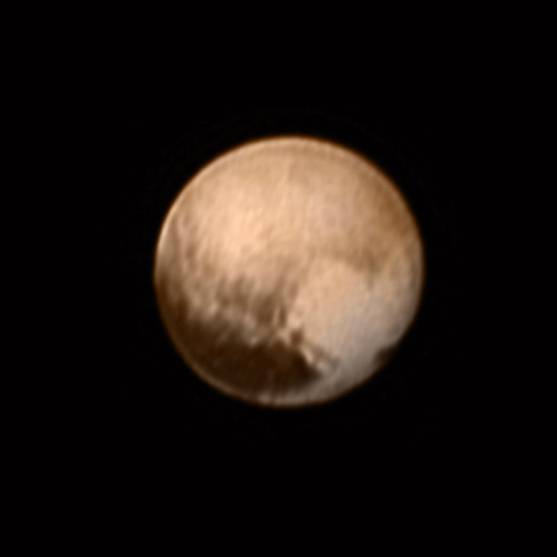July 2015
Monthly Archive
July 11, 2015
Posted by plutovian under
New Horizons
1 Comment
From the New Horizons mission page at NASA, these spectacular shots — our newest information about our most distant world. And the old human instincts, at seeing something previously unseen, to wonder and rejoice.
We’re still 3.3 million miles out. Closest approach, in three days’ time — 7800 miles.



July 10, 2015
CNN (and everybody else in the world) is telling the same old story today, under the headline 12 THINGS TO KNOW ABOUT PLUTO:

I mean, it’s true that she suggested it, but so did about a billion other people. Why does Venetia get the credit? Well, I have a theory.
Here, for the record, are some letters and telegrams from just a few of the other folks who had the same idea.
March 17, 1930
Dr. V.M. Slipher
Lowell Observatory
Flagstaff, Ariz.
Dear Sir;
I have read in the paper the account of the finding of the new planet and being interested I would like to suggest the name of Pluto. I chose this name because I believe this planet is as important as Neptune or Jupiter and deserves the name of the third brother.
Yours very truly,
Ruth van Sickle
Barringer High School
*
73FN B 23
CA CAMBRIDGE MASS 546P MAR 15 1930
DR V M SLIPHER
LOWELL OBSERVATORY FLAGSTAFF ARIZ
SUGGEST YOU CALL NEW PLANET PLUTO AFTER THE GOD OF UNDERWORLD THE SON OF SATURN AND ONLY REMAINING BROTHER OF JUPITER AND NEPTUNE
NOSTRADAMUS
419P
*
4 AU D 32 NL
WORCESTER MASS MAR 15
V M SLIPHER
LOWELL OBSERVATORY, FLAGSTAFF AZ
APPROPRIATE NAME FOR PLANET WOULD BE PLUTO THE VIEWLESS WHO MOVED HITHER AND YON DARK UNSEEN MYSTERIOUS STOP SEE GAYLEYS CLASSIC MYTHS STOP VULCAN SEEMS INAPPROPRIATE NAME FOR COLDEST PLANET
H L BLOOD
1157 AM
*
Indianapolis, Ind.
Mar. 16, ’30
Mr. Roger Lowell Putnam,
Dear Sir;
I suggest the name “Pluto” for the new Planet. “Atlas” is inappropriate as are others I have heard. The major planets are all named for the ancient gods. Saturn, the father of the gods, has the most distinctive world and two of his three sons are honored, Jupiter and Neptune, now in all fairness let us give the other, Pluto, his due.
As Pluto was Lord of the dark region of the dead, so this planet so far from the source of light should receive his name. Do not break the beautiful system and catalogue the new world by a name which has no real reason in it and will mean nothing to the future generations. Let us not do something for which we will have to apologize in future.
Respfly
Geo. P. Kebbe
July 10, 2015
Amazing photograph of Clyde (standing, mustache) out on the farm in Burdett, Kansas. Click the image to get the full-sized version.

Writing about Clyde’s days at home was one of the great pleasures, and challenges, of Percival’s Planet.
July 10, 2015
Yeah. Constance Lowell had a lot of bad ideas, but her bad ideas for naming the newly discovered Planet X were…the baddest of all. Here’s her letter to Lowell Observatory director Vesto Slipher, in February 1930:
Dr. Slipher—
Roger Putnam has written me about the intensely interesting observation that you are experiencing—that it may be Planet X I pray. Mr. Putnam asked me if I had any thoughts about the name. He said he had thought of “Diana”.
But no. If it is not to be Lowell or Percival my choice is Zeus.
Zeus being the father of Aries—Aries being identified with Mars—it seemed appropriate—and Dr. Lowell was born in the sign of Aries—it is Dr. Lowell’s planet after all his years of looking for it. And it is only right that it was his to name after himself and now my right as he is dead and gone, in the Air of the Universe—and he was like a Zeus—
Sin yrs
Const Lowell
July 10, 2015
Yesterday we got the first surface resolution of Charon, Pluto’s largest (and first discovered) moon. 
(Thanks as always to the excellent io9.com for this composite picture.)
Charon wasn’t discovered until 1978 — almost fifty years after Clyde Tombaugh first spotted Pluto’s infinitesimal speck on those big glass plates he’d exposed during hour-long sessions at the 13-inch telescope atop Mars Hill. Here’s the Zeiss Blink Comparator he used to compare one plate with another. (Formerly housed in the beautiful Saturn Dome room at Lowell Observatory, the comparator has now been moved to the Smithsonian Institution.)
It’s hard to convey exactly how tiny the speck of Pluto is on those plates — but boy, is it tiny. So small, in fact, that Pluto could easily have gone undiscovered for decades. Only a man like Clyde Tombaugh — diligent, devoted, impossibly obsessive — could have found it. Read more about Clyde’s homemade telescope here, and more about Clyde generally here.
And if you’re so inclined, you can check out my novel about Clyde Tombaugh and the discovery of Pluto here. Order one here today! (End of commercial.)
July 9, 2015
and what we do. A great explanatory video here from the New York Times. And this screenshot of the capsule containing Clyde’s ashes. Go, Muron’s boy!

July 9, 2015
Here we go, folks.
A small portion of Tombaugh’s ashes are on board the New Horizons probe.
Clyde, you’re almost there.








